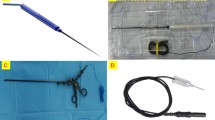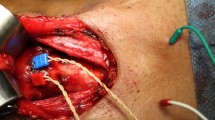Abstract
Background
The novel concept of continuous intraoperative neuromonitoring (Cont-IONM) through stimulation of the vagal nerve has been used in thyroidectomies to prevent imminent injury of the recurrent laryngeal nerve (RLN). This article reports on this technology and the results of using transoral Cont-IONM in natural orifice transluminal endoscopic surgery for thyroid disease.
Methods
Cont-IONM of the RLN was achieved through automatic cyclical stimulation of the vagal nerve using a C2 monitor and delta stimulating electrode. During the operation, three vestibular incisions were made, and the stimulating electrode was transorally inserted, with its cable line lying outside the trocar. The vagal nerve was gently dissected, looped, and then enveloped by the electrode cuff. Electromyography (EMG) of the vocalis muscle was performed, and the alarm was set to activate when the EMG amplitude reduced by 50% and latency was prolonged by 10%. Demographic data and outcome variables, including incremental time required to achieve Cont-IONM, were obtained.
Results
A total of 20 patients (28 nerves at risk) undergoing a transoral endoscopic thyroidectomy vestibular approach were enrolled in this study. All Cont-IONM procedures were successfully completed. In all patients, the stimulation was set at 0.7 milliamps every 1 s, and Cont-IONM use was unassociated with any untoward neural, cardiovascular, or gastrointestinal sequelae. On average, the ipsilateral Cont-IONM procedure required 10.33 ± 2.57 min to complete. Except for one instance, no significant problems occurred with electrode displacement. In one patient, a combined EMG event occurred, which improved after releasing the thyroid retractor, and the patient had no vocal cord paralysis postoperatively.
Conclusion
Cont-IONM is feasible and safe to use during transoral endoscopic thyroidectomies and may assist in the early detection of adverse EMG changes, thereby preventing paralysis of the RLNs.






Similar content being viewed by others
References
Randolph GW, Dralle H, Abdullah H, Barczynski M, Bellantone R, Brauckhoff M, Carnaille B, Cherenko S, Chiang FY, Dionigi G, Finck C, Hartl D, Kamani D, Lorenz K, Miccolli P, Mihai R, Miyauchi A, Orloff L, Perrier N, Poveda MD, Romanchishen A, Serpell J, Sitges-Serra A, Sloan T, Van Slycke S, Snyder S, Takami H, Volpi E, Woodson G (2011) Electrophysiologic recurrent laryngeal nerve monitoring during thyroid and parathyroid surgery: international standards guideline statement. Laryngoscope 121(Suppl 1):S1–S16
Shedd DP, Burget GC (1966) Identification of the recurrent laryngeal nerve. Arch Surg 92:861–864
Ghani U, Assad S (2016) Role of intraoperative nerve monitoring during parathyroidectomy to prevent recurrent laryngeal nerve injury. Cureus 8:e880
Hermann M, Hellebart C, Freissmuth M (2004) Neuromonitoring in thyroid surgery: prospective evaluation of intraoperative electrophysiological responses for the prediction of recurrent laryngeal nerve injury. Ann Surg 240:9–17
Caragacianu D, Kamani D, Randolph GW (2013) Intraoperative monitoring: normative range associated with normal postoperative glottic function. Laryngoscope 123:3026–3031
Snyder SK, Lairmore TC, Hendricks JC, Roberts JW (2008) Elucidating mechanisms of recurrent laryngeal nerve injury during thyroidectomy and parathyroidectomy. J Am Coll Surg 206:123–130
Liu XL, Wu CW, Zhao YS, Wang T, Chen P, Xin JW, Li SJ, Zhang DQ, Zhang G, Fu YT, Zhao LN, Zhou L, Dionigi G, Chiang FY, Sun H (2016) Exclusive real-time monitoring during recurrent laryngeal nerve dissection in conventional monitored thyroidectomy. Kaohsiung J Med Sci 32:135–141
Chiang FY, Lu IC, Chang PY, Sun H, Wang P, Lu XB, Chen HC, Chen HY, Kim HY, Dionigi G, Wu CW (2015) Stimulating dissecting instruments during neuromonitoring of RLN in thyroid surgery. Laryngoscope 125:2832–2837
Lamade W, Meyding-Lamade U, Buchhold C, Brauer M, Brandner R, Uttenweiler V, Motsch J, Klar E, Herfarth C (2000) First continuous nerve monitoring in thyroid gland surgery. Der Chirurg; Zeitschrift fur alle Gebiete der operativen Medizen 71:551–557
Lorincz BB, Mockelmann N, Busch CJ, Hezel M, Knecht R (2016) Automatic periodic stimulation of the vagus nerve during single-incision transaxillary robotic thyroidectomy: feasibility, safety, and first cases. Head Neck 38:482–485
Witzel K, von Rahden BH, Kaminski C, Stein HJ (2008) Transoral access for endoscopic thyroid resection. Surg Endosc 22:1871–1875
Anuwong A (2016) Transoral endoscopic thyroidectomy vestibular approach: a series of the first 60 human cases. World J Surg 40:491–497
Chiang FY, Lee KW, Chen HC, Chen HY, Lu IC, Kuo WR, Hsieh MC, Wu CW (2010) Standardization of intraoperative neuromonitoring of recurrent laryngeal nerve in thyroid operation. World J Surg 34:223–229
Schneider R, Randolph GW, Sekulla C, Phelan E, Thanh PN, Bucher M, Machens A, Dralle H, Lorenz K (2013) Continuous intraoperative vagus nerve stimulation for identification of imminent recurrent laryngeal nerve injury. Head Neck 35:1591–1598
Mattsson P, Hydman J, Svensson M (2015) Recovery of laryngeal function after intraoperative injury to the recurrent laryngeal nerve. Gland Surg 4:27–35
Paniello RC, Rich JT, Debnath NL (2015) Laryngeal adductor function in experimental models of recurrent laryngeal nerve injury. Laryngoscope 125:E67–E72
Chiang FY, Lu IC, Kuo WR, Lee KW, Chang NC, Wu CW (2008) The mechanism of recurrent laryngeal nerve injury during thyroid surgery–the application of intraoperative neuromonitoring. Surgery 143:743–749
Lamade W, Ulmer C, Seimer A, Molnar V, Meyding-Lamade U, Thon KP, Koch KP (2007) A new system for continuous recurrent laryngeal nerve monitoring. Minim Invasive Ther Allied Technol 16:149–154
Schneider R, Przybyl J, Pliquett U, Hermann M, Wehner M, Pietsch UC, Konig F, Hauss J, Jonas S, Leinung S (2010) A new vagal anchor electrode for real-time monitoring of the recurrent laryngeal nerve. Am J Surg 199:507–514
Lamade W, Ulmer C, Rieber F, Friedrich C, Koch KP, Thon KP (2011) New backstrap vagus electrode for continuous intraoperative neuromonitoring in thyroid surgery. Surg Innov 18:206–213
Lipton RJ, McCaffrey TV, Litchy WJ (1988) Intraoperative electrophysiologic monitoring of laryngeal muscle during thyroid surgery. Laryngoscope 98:1292–1296
Dionigi G, Donatini G, Boni L, Rausei S, Rovera F, Tanda ML, Kim HY, Chiang FY, Wu CW, Mangano A, Rulli F, Alesina PF, Dionigi R (2013) Continuous monitoring of the recurrent laryngeal nerve in thyroid surgery: a critical appraisal. Int J Surg 11(Suppl 1):S44–S46
Friedrich C, Ulmer C, Rieber F, Kern E, Kohler A, Schymik K, Thon KP, Lamade W (2012) Safety analysis of vagal nerve stimulation for continuous nerve monitoring during thyroid surgery. Laryngoscope 122:1979–1987
Author information
Authors and Affiliations
Corresponding author
Ethics declarations
Disclosure
All authors, Drs. Han-Kun Chen, Chun-Liang Chen, Yi-Feng Lin, Kai-Yuan Lin, Yih-Huei Uen, and Mr. Kuo-Shan Wen have no conflicts of interest or financial ties to disclose.
Electronic supplementary material
Below is the link to the electronic supplementary material.
Rights and permissions
About this article
Cite this article
Chen, HK., Chen, CL., Wen, KS. et al. Application of transoral continuous intraoperative neuromonitoring in natural orifice transluminal endoscopic surgery for thyroid disease: a preliminary study. Surg Endosc 32, 517–525 (2018). https://doi.org/10.1007/s00464-017-5656-0
Received:
Accepted:
Published:
Issue Date:
DOI: https://doi.org/10.1007/s00464-017-5656-0




